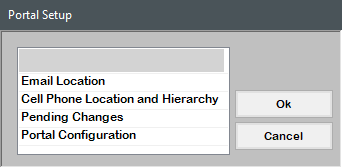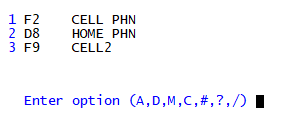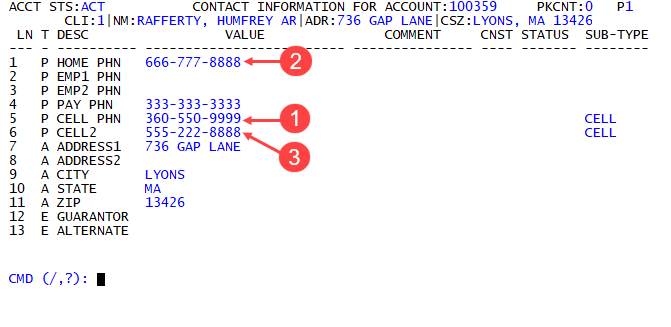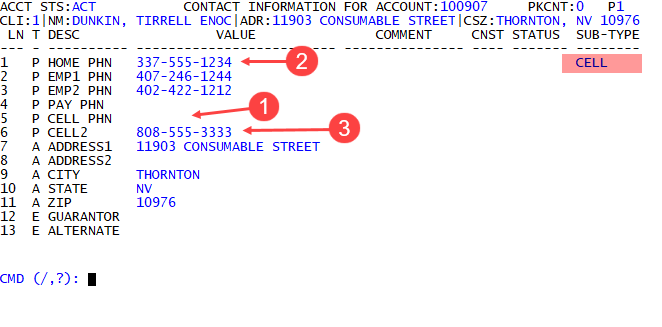Portal cell phone location and hierarchy
The Cell Phone Location and Hierarchy table allows you to specify which field(s) in The Collector System store consumer cell phone numbers. This table is used to determine which phone number will populate the Consumer Portal's cell phone field, as well as which fields in TCScan be updated if a consumer changes or adds a cell phone on the Consumer Portal.
Within the cell phone location table, phone locations are prioritized by descending order. If no phone number is found in the first designated location, location two is checked, and so forth until a cell phone number is found that can populate the Portal’s Cell Phone field.
If there are no current cell phone numbers for an account, the Portal's Cell Phone field will be blank. When a consumer inputs a phone number, the cell phone hierarchy table determines which field in The Collector System will store the newly input number.
Only cell phone locations and the Home Phone [D8] should be entered into the Cell Phone Location and Hierarchy table. Adding other non-cell phone fields is not recommended. Home phone numbers should be included because cell phones are now commonly used as a home phone number. It is important that a home number is correctly labeled with a “CELL” Sub-Type if it is a cell phone. This setting affects whether the home phone will be changed when an update is made from the Portal.
- From the Master menu, navigate to Utility > Cloud Services > Consumer Portal Serv (menu 9.58.5).
-
From the Portal Setup window, select Cell Phone Location and Hierarchy, and click Ok.

When setting up the Cell Phone Location table, it is recommended that an account's "primary" Cell Phone field is used for location one, followed by the account’s Home Phone location on line two. Any additional fields which store cell phone numbers can be added to lines three and beyond.
-
At the Enter option prompt, modify the cell location hierarchy list:
 Add a field
Add a field
- Type A, and press Enter.
- At the Line number prompt, do one of the following:
- To use the next available line, press Enter.
- To use a specific line number, type the line number, and press Enter.
- At the Cell location prompt, do one of the following:
- Type the field number, and press Enter.
- To select from a list of available phone fields, type ?, and press Enter.
- From the Available phone location(s) window, select a field, and press Enter of click Ok.
 Delete a field
Delete a field
- Type D, and press Enter.
- At the Line number to delete prompt, type the line number, and press Enter.
 Move a field
Move a field
- Type M, and press Enter.
- At the Line number to move prompt, type the line number, and press Enter.
- At the New line number prompt, do one of the following
- To use the next available line, press Enter.
- To use a specific line number, type the line number, and press Enter.
 Change a field
Change a field
- Type C, and press Enter.
- At the Line number to change prompt, type the line number, and press Enter.
- At the New value prompt, do one of the following:
- Type the field number, and press Enter.
- To select from a list of available phone fields, type ?, and press Enter.
- From the Available phone location(s) window, select a field, and press Enter of click Ok.
-
To exit the screen, do one of the following:
- To file changes and exit, type #, and press Enter.
- At the File Changes? prompt, click Yes.
- To exit the screen, type /, and press Enter.
- If you made any changes, at the File Changes? prompt, click Yes to save changes; otherwise click No.
- To file changes and exit, type #, and press Enter.
Example of configuring the Cell Phone Location and Hierarchy table
The example below shows a Cell Phone Location and Hierarchy table containing two cell phone fields and the home phone location. The primary cell phone field is entered in line 1, followed by the home phone number in line 2, and a secondary cell phone number in line 3.

Below is a screen shot of an account's Personal Contacts screen. The numbered phones show the order used to determine the cell location for the Consumer Portal based on the phone location table. The phone fields on lines 2 through 4 are not a cell phones and were not added to the location table, which excludes them from being considered.
When the consumer brings up their account in the Portal, the cell phone field will display the number stored in F2 (CELL PHN) because that is the first location in the Cell Phone Location and Hierarchy table. If F2 had been blank, the Portal would then have checked location two, which is the HOME PHN number stored in D8.
If a consumer deletes or changes their cell phone number via the Portal, the update is applied to same field in TCS where the original was stored. In this case, the number stored in F2 (CELL PHN) would be updated because it is first in the hierarchy.

In this second example, the screen shot below shows no primary cell phone number (F2) in location one, a home phone (D8) in location 2, and an additional cell phone (F9). The other two numbers in the screen below are not in the cell phone table, so they are not considered. In this example, because there is no primary cell, and because the home phone has a "CELL" Sub-Type, the home phone will display in the cell phone field on the Portal.
So, if a consumer deletes or updates the cell phone field in Portal, the home phone will get updated or deleted in The Collector System. However, if the home phone did not have a “CELL” Sub-Type, the home phone would not be changed and the next number in the hierarchy (CELL2 on line 6) would be used to store the new number while the home phone remains unchanged.
